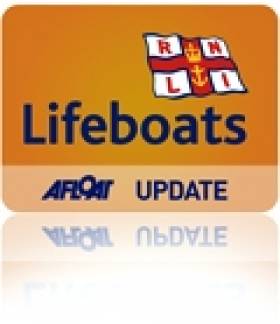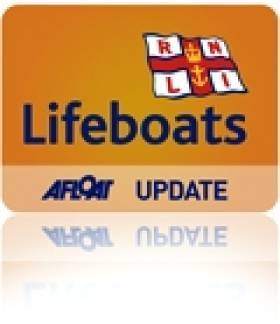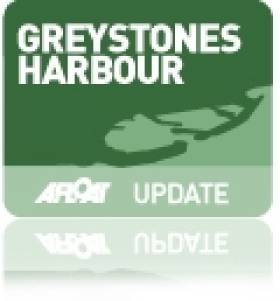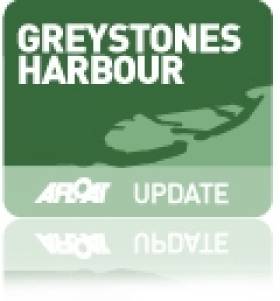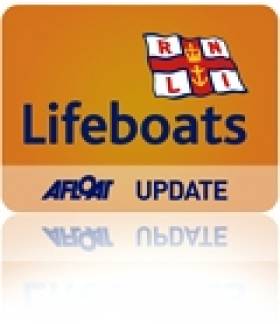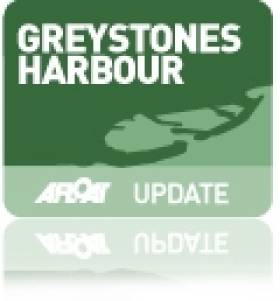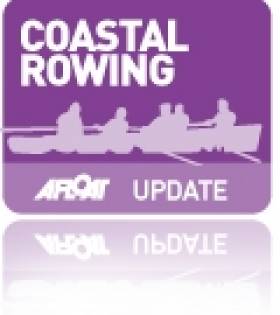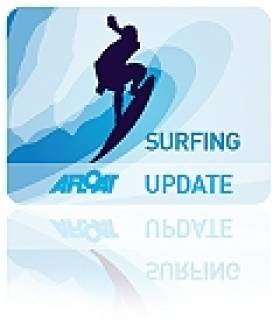Displaying items by tag: Wicklow
Arklow RNLI Rescues Couple From Yacht With Fouled Propeller
#RNLI - Arklow RNLI rescued a man and woman after their 12m yacht got into difficulty of the Wicklow coast yesterday afternoon (Wednesday 19 June).
The volunteer crew was requested to launch their all-weather lifeboat at 12.23pm following a report that a vessel was in distress four miles north of Arklow.
The man and woman on board the stricken vessel had been travelling from Scotland and were Arklow-bound on their journey home to Kent when they got into difficulty. Weather at the time was good.
Arriving on scene, the crew on board the lifeboat Ger Tigchelaar - under coxswain Ned Dillon - assessed the situation and observed that the vessel’s propeller had been fouled.
The stricken yacht’s crew had made efforts to clear the fouled lines. A tow line was quickly established and the vessel was towed safely back to Arklow.
Speaking after the call-out, Arklow RNLI volunteer lifeboat press officer Mark Corcoran said: "The man and woman on board the yacht this afternoon came into the lifeboat station to express their appreciation to the crew who were delighted to assist and to be able to bring them and their vessel safely to shore."
Crew members on board the lifeboat included coxswain Ned Dillon, mechanic Michael Fitzgerald, Brendan Dillon, Roger Tyrell and Andy O’Loughlin.
J109 'Ruth' Wins Lynx MetMast Trophy in Race to Wicklow
There was a slightly disappointing number of twelve boats that left Pwllheli marina for the earlier start of 07.45 on Saturday 1st May for ISORA's race four from Pwllheli to Wicklow writes Peter Ryan.
Those that took part were again rewarded with great sailing conditions if not slightly frustrating at the end.
The previous evening the series Sponsor lynx metmAsts hosted a reception in PSC where the "lynx metmAsts Offshore Perpetual Trophy" for the race was on display. The usual great social activity the ISORA is famous for lasted well into the night and even into the early morning!!!
The forecast was giving 10-12 knots westerly / south westerly going very light in the afternoon and then veering north easterly in the evening. There
appeared to be a differences in forecasts received by some competitors!! The agreed course for the race was direct to Wicklow.
The race was started at the Pwllheli SC Bridge by Richard Tudor in the forecast winds producing a fast reach towards St. Tudwal's. J boats, "Ruth" and "Jetstream" were out of the blocks early and took a commanding lead from the start. Exiting the Tudwals sound the fleet hardened up to punch into the tide towards Bardsey. As Bardsey Island was not a mark on the course a decision was needed then as to what side to take the island against a strong south going tide.
"Raging Bull" was the first to head south outside the island while most of the fleet stayed close to the shore. The leaders "Ruth" and "Jetstream" did not get close enough to the north shore of Bardsey Sound and soon found themselves being pushed south across the sound by the tide. "Mojito" followed by "Sgrech" hugged the shore but "Mojito" tacked out too early and lost some of the advantage. Most of the fleet observing the advantage gained by "Sgrech" followed along and close to the north shore of the sound.
This was the stage that the accuracy of the forecast was critical. "Raging Bull", "Ruth", "Mojito" and "Jetstream" found themselves heading south on the beat to Wicklow. "Sgrech", "Lula Belle", Yachtzee" and "Predator" took the northerly tack. "Sgrech" was positioning itself for the North westerly wind that was due. Other forecasts spoke of the winds backing south!!!. Who was to be right?
Initially the tack south shot those boats far south with the tide. Very soon there was a significant split in the fleet. It looked that the south going boats had the advantage as the winds went light in the afternoon and rose again with no signs of the north westerly. South boats "Ruth", Mojito" and "Jetstream" were powering into the finish when Wicklow struct back!!! Not only did the winds drop in the fast going south tide but veered north westerly.
"Ruth" managed to beat against the tide and get across the line but "Mojito" was pushed south past Wicklow Head before managing the get moving again.
Similarly "Jetstream" had the beat north against the tide. "Sgrech", noticing what was happening and who had been at that time desperately trying to get south after thinking the north westerly would never come, headed again north and managed to get infront of "Mojito" and Jetstream" to cross the line second. "Predator" and "Raging Bull" followed behind.
After the Class 1 boats struggled into Wicklow, the wind dropped even further causing grief for the Class 2 boats. "Ruth" was the first to cross the finish line at 19.18 while the last boat finished at 01.00. The finisher in Wicklow was President of WSC, Sadie Phelan.
"Ruth" took line honours, Overall and Class 1 while "Sgrech" took 2nd place Overall and Class 1. The four J109 boats took the first four places overall reinforcing their dominance offshore. "Ruth" also wins the "lynx metmAsts Offshore Perpetual Trophy" and keeps the replica.
The usual great welcome was received in Wicklow and it allowed the crews to chat about the race over a glass of sherry and a large slice of Pizza, compliments of Liam Shanahan "Ruth".
The next race is the D2D race to Dingle on the 7th June. With the Series wide open this race could be a decider.
#RNLI - Dun Laoghaire RNLI was involved in the recovery yesterday afternoon of a sinking boat following the rescue of three people after the vessel began to sink off the Wicklow coast.
Three people were pulled from the water when their small boat got into difficulty off Bray on Sunday 12 May.
A local boat responded to the Mayday alert and brought the casualties to safety.
The RNLI lifeboat from Dun Laoghaire and the Greystones Coast Guard boat took the boat that was almost fully submersed under tow to shore.
Winds gusted to storm force towards the end of the operation but conditions were otherwise fresh, with only choppy waves off the coast.
The incident occurred shortly after midday when the 15ft speedboat was almost one mile from Bray Harbour.
First Boats Welcomed into Greystones Harbour Marina
#greystonesharbourmarina – Greystones in County Wicklow welcomed the first boats into the harbour's new marina this week after the 100-berth facility opened on time in spite of a prolonged period of easterly gales making the month of March the coldest since records began.
It was chilly work but in spite of the gales the marina opened on time and it was rewarded with plenty of seagoing interest from visiting sailing and motor cruiser craft, travelling down from nearby Dublin Bay to check out the new facility and to be welcomed by newly appointed operators BJ Marinas Ltd.
Less than a week since opening nine boats are safely berthed in the new marina.
Since arriving on site in December operators BJ Marinas Ltd have been working around the clock to ensure they met their target of being open for the start of the boating season on 1st April.
Managing Director Bernard Gallagher said "We're delighted to open on time! It's a unique and stunning site and we're looking forward to our first season!
BJ started taking bookings in late January and have had a steady stream of commitment from berth holders since then.
There will be 100 berths initially ranging from six metres to 30 metres. Once completed there will be 230 berths.
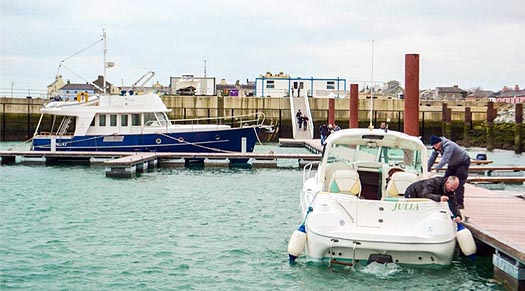
Some of the first boats arriving into Greystones Harbour Marina on Monday, April 1
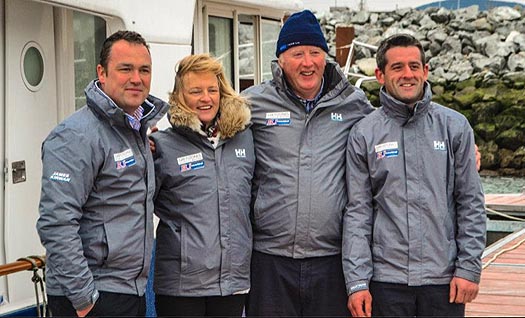
The BJ team at Greystones Harbour marina (from left) James Kirwan, Marie Parkes, Bernard Gallagher and Ross Hall
Greystones Harbour Marina Opens on Easter Monday
#greystonesharbourmarina – The Irish Sea's newest marina opens in Wicklow on Easter Monday. Greystones Harbour Marina will open on 1st April 2013 with 100 berths available initially.
Since arriving on site in December operators BJ Marinas Ltd have been working around the clock to ensure they met their target of being open for the start of the boating season on 1st April.
Managing Director Bernard Gallagher said "We're delighted to be appointed as harbour and marina operators. It's a unique and stunning site and we're looking forward to opening this new marina on Monday'
BJ started taking bookings in late January and have had a steady stream of commitment from berth holders since then.
There will be 100 berths initially ranging from six metres to 30 metres. Once completed there will be 230 berths.
French Trawler Rescued By RNLI Lifeboat off Wicklow Head
#rnli – Wicklow RNLI has rescued four fishermen from a 26m French fishing trawler which got into difficulty in the early hours of this morning (Friday 22 March).
The volunteer lifeboat crew responded rapidly and in severe weather conditions when requested to launch by the Irish Coast Guard at 3.15am.
The Mayday call was to go to the aid of a 120 tonne French fishing trawler, the Bara An Aod, which had suffered engine failure two and a half miles east off Wicklow Head.
The four crew members aboard the French boat had been on a delivery passage from France to Ireland when the vessel got into trouble.
Weather conditions at the time were blowing a strong south easterly force nine gale with torrential rain and a three to four metre breaking swell.
Arriving on scene at 3.55am on what was its first call out of the year, the all-weather lifeboat the Annie Blaker, and her crew under Coxswain Nick Keogh, located the trawler and proceeded to establish a towline.
The stricken vessel was subsequently towed safely back to Wicklow Harbour by the lifeboat where it arrived at 5am.
Speaking after the call out, Tommy Dover, Wicklow RNLI Volunteer Lifeboat Press Officer commended the efforts of an experienced lifeboat crew who he said was met with challenging weather conditions in the dark hours of the morning: 'The crew responded very quickly to the Mayday call and had the lifeboat launched within 10 minutes of being alerted. It was such a bad night but the experienced crew confident in the lifeboat's ability to meet the conditions, skilfully responded and were thankful and delighted to be able to assist the four crew members and their vessel safely to shore this morning.'
The lifeboat crew on this call out included Coxswain Nick Keogh, mechanic Brendan Copeland, Ciaran Doyle, Tom McAuley, John Vize, Connie O'Gara and Graham Fitzgerald.
Greystones Harbour Marina Rates & Application Form Here!
#greystonesmarina – Greystones Harbour and Marina in County Wicklow announced its berthing rates today two months ahead of its scheduled opening for the 2013 boating season. An application form has alos been published. You can download the rates and application form below as pdf documents below.
The much anticipated rates are as follows: An annual berth licence is €375 per metre. A six month (April to September) berth licence is €275 per metre. A 'casual' one month licence is also on offer at €60 per metre.
Daily visitor rates are also published at €3.50 per metre
The terms say that a 20% deposit is required to secure berth with the balance due before April 1 2013
The 100-berth marina has confirmed it will be open from the 1st April, 2013.
Operators BJ Marinas Ltd say they have received over 100 berth enquiries to date and are looking forward to a busy first season.
East Coast Rowing Council Announces 2013 Regattas
#CoastalRowing - The East Coast Rowing Council has announced its list of coastal rowing regatta fixtures in Dublin, Wicklow and Wexford for the 2013 season.
Commencing with the Greystones Regatta on 26 May, the schedule also includes events in Arklow (2 June) and Dalkey (9 June), the Stella Maria Regatta in Ringsend on 16 June and the Bray Regatta on 30 June.
July will see two events, the St Patrick's Regatta in Dublin's Docklands on 14 July and St Michael's Regatta off Monkstown and Dun Laoghaire on 28 July, while the Wicklow Regatta will mark the end of 2013's summer events on 5 August.
Locations of the various regattas and suggested viewing points are available HERE.
Surfing is Ireland's 'Best Kept Secret' No More
#SURFING - Ireland can no longer claim to be the surfing world's best kept secret, as the Irish Examiner reports, as thousands of waveriders of all skill levels now flock annually to the west and northwest coasts to sample the swell.
Indeed, Ireland is arguably the hottest place to be for surfing right now, and RTÉ Travel rounds up the best spots to hit the water around the coast - including some that might surprise you.
Bundoran is this country's surfing mecca, and for good reason. Recently making National Geographic's list of the world's top 20 surfing towns, the Co Donegal surf capital has spots for everyone from experts to beginners, and boasts a choice of 10 surf schools affiliated with the Irish Surfing Association.
Further down the coast is Sligo, renowned among the surfing elite for the giant rollers off Mullaghmore Head but also a great place for learners, especially at Strandhill and Enniscrone - although "big waves, clean waters and great surfing" are to be found anywhere along the coastline.
Mayo continues the trend, with Bertra in Clew Bay and Keel Strand in Achill standing out, while Clare is home to the famed waves at Lahinch - home turf for big wave surfer Ollie O'Flaherty.
Further along, Kerry and West Cork can boast of a number of top-class surfing destinations, including some stretches just perfect for absolute beginners.
But it doesn't end there, as even the southeast and east coasts can hold their own - as Tramore in Co Waterford and Brittas Bay in Co Wicklow can attest.
Round Ireland (Thurs 3pm). Can Inis Mor do it?
#roundireland – While the official tracker has Inis Mor as the overall leader in the 2012 Round Ireland Race, it's going to be a nail biting few hours for the French boat.
As of 3pm, Inis Mor has 30.6 miles to go. To beat Tonnerre she needs to cover that distance in five hours and 34 minutes. Simple math says she needs to average 5.49 knots and as she is making 5.7 knots just south of Lambay Island, it should work for her.
But, the 5.7 knots is not quite in the right direction – because the wind has headed her, she can only make 221° instead of the 190° she needs to reach Wicklow on one tack. So while 5.7 knots looks good, her actual progress towards the finish or VMG, is currently 5.4 knots – just outside the 5.49 knots needed.
To make matters worse, she is entering an area of stronger tides that will be directly against her for the last few hours into Wicklow. She can mitigate some of this by hugging the coast, but at what cost windwise?
Fascinating stuff, www.afloat.ie's money's on Tonnerre, at least in this battle. Keep an eye on Cavatina though – she still has a day left to win!


























